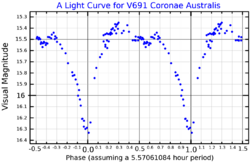Astronomy:V691 Coronae Australis
| Observation data Equinox J2000.0]] (ICRS) | |
|---|---|
| Constellation | Corona Australis |
| Right ascension | 18h 25m 46.8186s[2] |
| Declination | −37° 06′ 18.529″[2] |
| Astrometry | |
| Radial velocity (Rv) | −91.0[3] km/s |
| Proper motion (μ) | RA: −9.222[2] mas/yr Dec.: −2.542[2] mas/yr |
| Parallax (π) | 0.1205 ± 0.0577[2] mas |
| Distance | approx. 30,000 ly (approx. 8,000 pc) |
| Details | |
| Neutron star | |
| Mass | 1.14–2.32 M☉ |
| Database references | |
| SIMBAD | data |
X1822–371, associated with the optically visible star V691 Coronae Australis (abbreviated V691 CrA), is a neutron-star X-ray binary system at a distance of approximately 2-2.5 kiloparsecs.[4] It is known to have a high inclination of i = 82.5°± 1.5°.[5] This source displays relatively high brightness in the optical wavelengths when compared to the X-ray, making it a prototypical Accretion Disk Coronae (ADC) source, i.e. a source with a corona extending above and below its accretion disk. The only-partial eclipses in its light curve, even at such a high inclination, support this hypothesis. Estimates of the mass of its neutron star lies between 1.14–2.32 solar masses. The optical spectrum of X1822–371 displays strong Hα, Hβ, He I, He II and Bowen Blend features. These features have been extensively studied using the technique of Doppler tomography.[6][7][8]
References
- ↑ Cowley, A. P.; Schmidtke, P. C.; Hutchings, J. B.; Crampton, David (April 2003). "A Spectroscopic and Photometric Study of the Eclipsing Low-mass X-Ray Binary 2A 1822-371 (V691 Coronae Australis". The Astronomical Journal 125 (4): 2163–2172. doi:10.1086/368137.
- ↑ Jump up to: 2.0 2.1 2.2 2.3 2.4 Brown, A. G. A. (August 2018). "Gaia Data Release 2: Summary of the contents and survey properties". Astronomy & Astrophysics 616: A1. doi:10.1051/0004-6361/201833051. Bibcode: 2018A&A...616A...1G. Gaia DR2 record for this source at VizieR.
- ↑ Duflot, M.; Figon, P.; Meyssonnier, N. (1995). "Vitesses radiales. Catalogue WEB: Wilson Evans Batten. Subtittle: Radial velocities: The Wilson-Evans-Batten catalogue". Astronomy and Astrophysics Supplement Series 114: 269. Bibcode: 1995A&AS..114..269D.
- ↑ Mason, K. O.; Cordova, F. A. (November 1982). "Infrared photometry of the X-ray binary 2A 1822-371 - A model for the ultraviolet, optical, and infrared light curve" (in en). The Astrophysical Journal 262: 253. doi:10.1086/160416. ISSN 0004-637X. Bibcode: 1982ApJ...262..253M.
- ↑ Heinz, S.; Nowak, M. A. (2001-01-11). "The Flared Disc Project: RXTE and ASCA observations of X 1822--371" (in en). Monthly Notices of the Royal Astronomical Society 320 (2): 249–260. doi:10.1046/j.1365-8711.2001.03946.x. ISSN 0035-8711. Bibcode: 2001MNRAS.320..249H.
- ↑ Peris, C. S.; Vrtilek, S. D. (2012-12-01). "A tomographic study of V691 CrA (X1822−371): A tomographic study of V691 CrA (X1822−371)" (in en). Monthly Notices of the Royal Astronomical Society 427 (2): 1043–1051. doi:10.1111/j.1365-2966.2012.22039.x.
- ↑ Somero, A.; Hakala, P.; Muhli, P.; Charles, P.; Vilhu, O. (March 2012). "Phase-resolved optical and X-ray spectroscopy of low-mass X-ray binary X1822-371" (in en). Astronomy & Astrophysics 539: A111. doi:10.1051/0004-6361/201118439. ISSN 0004-6361. Bibcode: 2012A&A...539A.111S.
- ↑ Casares, J.; Steeghs, D.; Hynes, R. I.; Charles, P. A.; O’Brien, K. (2003-06-20). "Bowen Fluorescence from the Companion Star in X1822−371" (in en). The Astrophysical Journal 590 (2): 1041–1048. doi:10.1086/375055. ISSN 0004-637X. Bibcode: 2003ApJ...590.1041C.
 |


